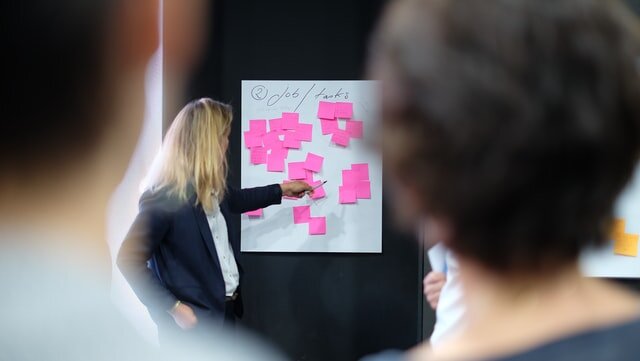How to Run a Successful Corporate Hackathon
Corporate Hackathons provide a great way to inspire teams and promote creativity, collaboration, and innovative thinking. Read below a detailed guide on how to set up a hackathon to best serve your strategy and goals.
If run properly, a series of hackathons can establish a stream of valuable ideas. It can also have a significant cultural effect on your team, potentially awakening an experimentation and innovation mindset
This article explains different types of hackathons. It presents how to set the objectives, success criteria, and other important aspects of your hackathon.
According to Wikipedia, a hackathon is defined as “ … a design sprint-like event in which computer programmers and others involved in software development, including graphic designers, interface designers, project managers, and others, often including subject-matter-experts, collaborate intensively on software projects”
In practice, it is frequently used to describe any idea-generation initiative with or without functional software deliverables.
My definition would be:
An intensive, software-centric ideation, prototyping and presentation challenge on known or unknown problems or opportunities.
Intensive in the above definition implies a time-boxed process asking participants for the ‘impossible’ — to come up with novel solutions to particular problems or innovative ideas and prototypes regarding new business opportunities.
Hackathons are technology-driven and primarily about software — hence the software-centric element in the definition. A Hackathon is very demanding on participants — it requires not only great technical and coding skills but also ideation and presentation skills.
Participants are asked to come up with great ideas, formulate a prototype and prioritize wisely; then self-organize and execute — do quick research, prepare resources, write code, reuse existing components and systems and finally prepare a presentation — all in a time-boxed scenario. The Hackathon may be focusing on known problems or business opportunities or technologies (stated upfront) or it could be open to any ideas with no particular constraints.
→ Check also: Building an MVP: How to define the first instance of your product
1. Defining your Hackathon
Having a clear definition of your hackathon event (style, processes, objectives, awards) is key for its success. The major attributes defining your hackathon are:
Date, duration, lead time, and venues. Especially the lead-time is important in order to allow participants to get prepared by discussing ideas, teams, and collaboration scenarios. Depending on the case and the size of the corporation/ involved team, there should be a lead time of a few weeks.
Participation rules: the logic defining who is eligible to participate (for instance full-time employees from particular teams, venues, etc.)
Minimum Deliverable: the type of deliverable required for a successful submission — for example, is it a functional prototype + source code? a predictive model? a pitch video? this is key information that can have a significant impact on the participation rates
Context: the focus of the event in terms of technologies, particular business problems to be solved. For instance, it could be a Data hackathon or Robotics or AR/VR; or any technology, with a focus on a particular class of problems.
Scope: is it an internal, company-wide, or public event? A private hackathon could target particular teams or the entire corporation. A public hackathon accepts participants outside the corporation.
Assessment criteria and process: the rules, priorities, and processes in order to evaluate submissions (is there a voting process, a panel of experts? what are the dimensions to use when evaluating an idea?)
Award: number of winners and type of award
→ Check also: our unique Innovation Toolkit - a collection of seven innovation templates including hackathon definition and hackathon project assessment.
Setting the objectives, defining ‘Success’
Typically, a Hackathon event is expected to deliver at least a set of interesting, novel ideas. Ideally, there should be a few outstanding concepts, possibly with a prototype and quick proof of the concept/technology involved.
Beyond the obvious objective — to generate high-value actionable business ideas and product concepts— there is another aspect related to the team dynamics and the innovation mentality: a great hackathon should boost the innovation culture and further establish the idea-sharing, effective collaboration, and creativeness, driven by the enthusiasm towards a shared goal.
Employees have a great opportunity to discover technologies, teams and demonstrate their skills and talents outside their typical job description; Corporations have the opportunity to identify talent, experience powerful teams being set up, and capture valuable feedback.
How is success defined?
Success criteria depend on the particular context — business, industry, size of the corporation, timing, etc. In all cases, KPIs can be defined on some or all of the following:
Participation rate: this is an obvious indicator of one aspect of the success of the event — how employees responded to the ‘call to innovate’. The percentage over the total number of employees depends of course on the nature of the hackathon, the timing, the focus, etc. The target should be set after analyzing similar events within the same corporation.
The volume of Ideas: the volume of ideas generated is also significant, especially when analyzed against additional metadata (check also: principles of a great ideation platform)
Percentage of Actionable Ideas: the percentage of actionable ideas (those that are promising or worth further investment from a business point of view) is a good indicator of success.
Percentage of Business opportunities: those promising ideas which — after post-processing — proved to be valuable business opportunities worth further investment.
Percentage of IP-generating projects: those projects who are eligible and valuable for patent protection.
Conversion rates: the whole batch of ideas/concepts/projects generated should be monitored as a ‘cohort’ against time. This way ideas originated from a particular hackathon event but delivering value only after a period of time, will be also measured as a successful outcome.
Opportunities for publicity: measures of ‘media attention’ as the result of the hackathon event
Team impact: as captured from formal feedback processes — a great source of insights is the opinions of the participants and stakeholders. This could allow quantitative and qualitative analysis from many different angles including the effect on team dynamics and morale.
2. Running the Hackathon
Hackathons typically have a lead time — a preparation phase, from the announcement of the event to the actual ‘hack-time’, as explained below:
The ‘design time’
This is about communicating the event to the employees, attracting attention, and enabling formal registration of interest.
As soon as the Hackathon is announced, employees should have a sufficient lead time — typically a few weeks- to explore ideas, technologies, teams, and resources. This is an informal preparation phase that should be supported by proper tools (systems to enable employees to structure their ideas, projects, teams; communicate their effort, ask for advice or help). In all cases you should:
Announce the hackathon with clear messages and strong sponsorship from the leadership
Frequently and consistently communicate updates on the timeline of the event, the number of participants, the availability of the resources
Provide self-service tools for employees to register, create projects, explore projects, form teams, explore technologies, etc.
Assign a small team to support the process
The ‘run time’
This is where the magic happens — teams working intensively to align their ideas, define the ‘product’, execute, review, iterate; the most exciting and creative part of the hackathon where employees forget their formal roles and titles and self-organize focusing on their mission: to create something novel and impactful. Depending on the definition of each event, there might be a video pitch requirement, live pitching of the idea, or a live demo of the product/ prototype. In all cases the importance of effectively presenting the work done is critical. You should also:
Make sure that participants have dedicated time to work on their projects
Ensure that suitable physical space and equipment is available to all teams
The ‘assessment time’
Valid deliverables submitted by the teams are being assessed based on the protocol of the particular event. This could involve a voting process across the corporation, a panel of experts analyzing certain aspects of each project, or a combination of both. In certain cases, actual customers could also be involved and provide feedback on projects. Be mindful of the following:
Selecting winners based on popularity within the corporation is typically biased and probably misleading
The panel of experts should use predefined dimensions like, for example, feasibility, level of innovation, expected business impact, the opportunity for intellectual property, and potential for differentiation.
Winners & Awards
Depending on the structure of the particular event, there could be a single winning team or multiple winners across different categories. Selecting the award for each case is also a very significant aspect of the Hackathon — typically awards are monetary (for example a bonus), symbolic (plaques, cubes, title), or a piece of technology/device.
The most important though from a developer’s point of view is resources and sponsorship to drive the product/idea to the next stage. This could be the most inspiring award of all — the ability for the winning team to use specialized resources (developers, equipment, software, services) — according to a suitable plan — and get prepared for a formal presentation of the outcome to the senior stakeholders, leaders and decision makers. This type of award can drive impressive success stories of ‘hackathon projects moving to production’ and attach additional purpose to the event.
3. Analyzing the Business Value
Hackathons are expected to generate actionable ideas (for example features for an existing product), strategic product concepts (a new product to consider and further experiment with), and process improvements (novel, more efficient ways to do things).
At the team level, Hackathons provide a great way to inspire teams and promote creativity, collaboration, and innovative thinking. Programmed in the right way, hackathons can drive an important cultural shift within the team: the experimentation & innovation mindset.
A gamification layer on top of hackathons can further motivate and reward employees for being innovative while staying aligned with the strategy of the corporation.
→ Check also: our unique Innovation Toolkit - a collection of seven innovation templates that empower teams to frame problems, shape ideas, run hackathons, and more.












MVPs and Startups - Why should a startup follow the MVP approach? How do you prioritize features? Answering these and other frequent questions people ask me about Minimum Viable Products - MVPs